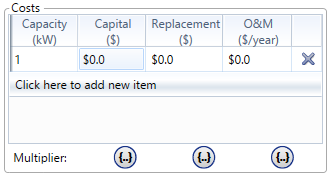
HOMER Pro 3.15

![]()
The Electrolyzer page contains the cost and performance inputs for the Electrolyzer, which generates hydrogen from electricity.
HOMER models the Electrolyzer in a very simple way. It assumes a constant efficiency, so that a certain amount of electricity will always result in a certain amount of hydrogen. It has a minimum load level, so if the Electrolyzer can only operate down to, say, 75% of its rated capacity you can set the minimum load to 75%. Normally the Electrolyzer receives only excess electricity (or surplus electricity), but when hydrogen is needed (to serve the hydrogen load or to fuel a generator required to serve an electric load) the Electrolyzer will demand electricity.
Costs
In the electrolyzer Costs table, enter the electrolyzer cost curve; i.e., the way the cost varies with size. Click the "Click to add new item" option to add more rows to the table.

If you have a particular electrolyzer in mind, you can enter its size and cost. In the example above, a 0.7 kW electrolyzer costs $1400 initially, $1200 to replace at the end of its life, and $30/yr for operation and maintenance.
Sizes
In the Capacity Optimization table, enter the electrolyzer sizes you want HOMER to consider as it searches for the optimal system. Be sure to include a zero size if you want to consider systems without an electrolyzer.

HOMER uses the information you entered in the cost table to calculate the costs of each electrolyzer size, interpolating and extrapolating as necessary. You can see the results in the cost curve graph.
Properties
|
Variable |
Description |
|
Lifetime |
The number of years the electrolyzer is expected to last before it requires replacement |
|
The energy content (based on the higher heating value) of the hydrogen produced divided by the amount of electricity consumed |
|
|
Minimum Load Ratio |
The minimum power at which the electrolyzer can operate, as a fraction of its rated capacity |
|
Electrical Bus |
Whether the electrolyzer consumes alternating current (AC) or direct current (DC) power |
Note: To the right of each numerical input is a
sensitivity button ( ) that allows you to do a sensitivity analysis on that variable. For more
information, see Why Would I Do a
Sensitivity Analysis?
) that allows you to do a sensitivity analysis on that variable. For more
information, see Why Would I Do a
Sensitivity Analysis?
